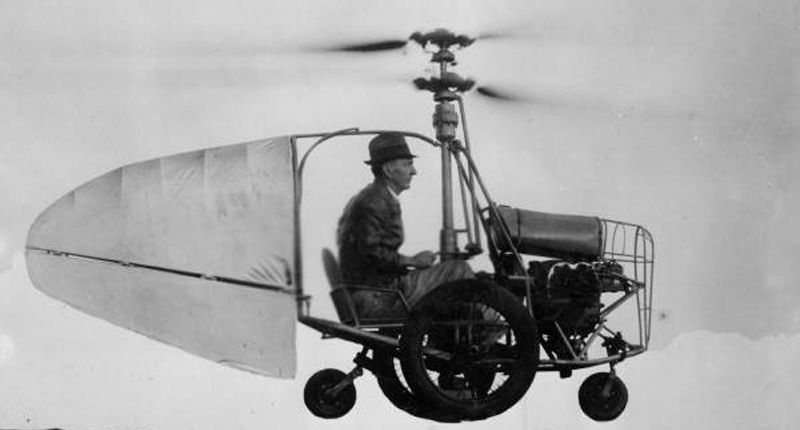A standout presence at Africa’s leading technology showcase Global leading AI device ecosystem company HONOR wrapped up a successful three days at the Africa…
4 brave (and on-going) attempts at the still-elusive flying car

We know what you’re thinking: it’s 2015… where’s my friggin’ flying car already?
Well, contrary to myriad flighty predictions, the winged automobile is still not a mass-produced reality. No, the imagined highways of the sky remain as deserted as your local bank on a Sunday afternoon.
Why? Well, there are all sorts of reasons, besides the obvious mechanical and financial challenges. And legal issues are chief among them. Think about it: would the driver need a pilot’s licence? What about restricted airspace? And would it really be all that much better mindlessly commuting with the same sorry throng of bumper-bashers in the air as you currently do on the ground?
Then there’s the frightening fact that a simple “breakdown†would be akin to dropping clean out of the sky. And we should, of course, also keep in mind the daunting prospect of flying a small vessel in inclement weather.
Okay, enough of the doom and gloom. There have, in fact, been a handful of brave attempts at the flying car – some of which may yet seen the light of day. Technically, these may be little more than small aircraft that double as road-legal cars, but what more would the driver-cum-flyer of the future really need?
So, here are four valiant, on-going attempts at the flying car.
1. AeroMobil 3.0
If you have even a passing interesting in the winged car, you’ll have heard of AeroMobil. This Slovakia-based company has been feverishly working away on the concept since around 1990, and the AeroMobil 3.0 is its latest effort.
Yes, it’s a road-legal car. And it flies, too. The AeroMobil 3.0 may be pretty hefty – it’s 6000mm long and 2240mm wide (or a full 8320mm with the wings out) – but the company still insists that it “fits into any standard parking spaceâ€. It also runs on regular petrol and can take off and land using “any grass strip or paved surface just a few hundred metres long†thanks to the variable angle of attack of the wings. Spiffy.
Powered by a Rotax 912 – a horizontally opposed 1352cc four-potter commonly used on small aircraft – the two-seater vehicle apparently boasts a range of 875km on tar or 700km in the air. As an automobile, its makers claim a top speed of 160km/h, a number that rises to over 200km/h when flying.
The AeroMobil 3.0 has been tested in real flight conditions – in fact, it’s still taking part in a regular flight-testing programme that started in 2014 – and the company says the prototype is “very close to the final productâ€. With bated breath we wait.
2. Terrafugia TF-X
Terrafugia may be another name you’ve heard bandied about in “flying car†circles. This US company has been developing the Transition “roadable airplane†since 2006, delaying the planned first customer delivery year after year… after year. The latest estimated production date? The second quarter of 2016.
In the meantime, the Massachusetts-based company has been busying itself with the Terrafugia TF-X. Take note, however, that this model is nowhere near production. In fact, it’s little more than a concept. But what a concept it is.
The TF-X differs from the Transition in that it’s a “vertical take-off and landing†craft. Yes, that means – just like a helicopter – there’s no runway required. How does it work? Well, the TF-X employs short wings featuring electrically driven rotors that point up for take-off before rotating to enable level flight.
Theoretical specifications include a flight range of around 800km, space for four people and the ability to squeeze into a single-car garage. According to reports covering Terrafugia’s 2013 reveal, development is expected to last up to 12 years. Ouch.
3. SkyRider X2R
Like the TF-X above, the SkyRider X2R has yet to be built, never mind actually take to the skies. But it’s an interesting concept nonetheless, using four “ducted fans†with wings to generate lift and maintain flight.
Macro Industries, the American company behind the idea, has billed the two-seater SkyRider X2R concept as a sort of autonomous vehicle of the sky. It says the flying car will use “robust computer technology combined with instant location and positioning systems to generate a skyway that the SkyRider will follow automaticallyâ€.
The craft would theoretically employ an “enhanced automobile engine†with normal petrol as its fuel. And the company adds that it would function more like a car than a plane, in that it would employ a steering wheel and a shift lever (the latter featuring park, hover, climb, cruise, etc. modes).
Whether the SkyRider X2R will actually become a reality remains to be seen. On its website, Macro Industries says the production model’s arrival date is “projected to be five years after receiving investment fundingâ€. But it seems they’re still waiting for cash…
4. Moller Skycar M400
Another “vertical take-off and landing†craft, the Moller Skycar M400 was thought up by Canadian engineer Paul Moller, who’s been tinkering with the notion of a personal flying car for around half a century (can you say “vapourware�).
A prototype version of the M400 has taken to the skies before – although it was tethered to an overhead crane (apparently for insurance purposes), with no pilot on board. Still, a production model is apparently still under development, even though Moller reportedly ran out of investors back in 2009, prompting reports branding the entire project a “failureâ€.
But, late in 2013, Moller initiated a crowdfunding campaign in a bid to raise capital for further development. When the campaign closed in early 2014, the grand total stood at $29 429, which fell spectacularly short of the $950 000 target.
Regardless, the Moller Skycar M400 is another intriguing concept: like the SkyRider X2R outlined above, it employs four ducted fans to move air vertically for take-off and horizontally for flight. Each fan is powered by a 530cc Wankel engine, which in turn results in a theoretical cruising speed of nearly 500km/h. Pie in the sky? Maybe…

